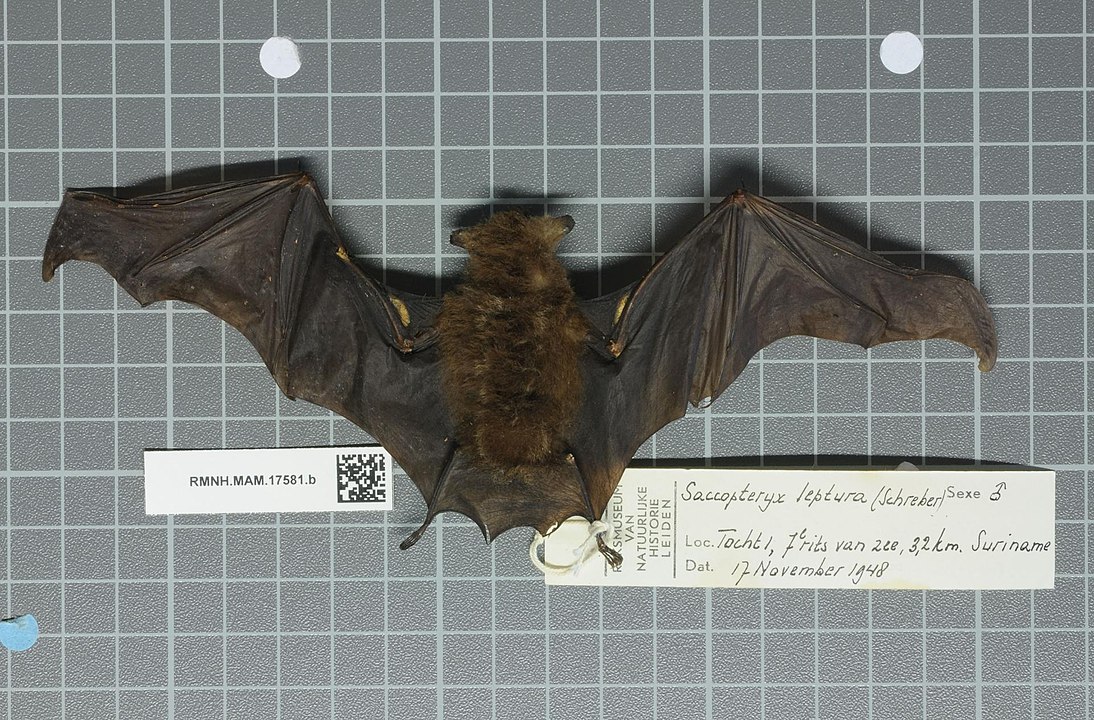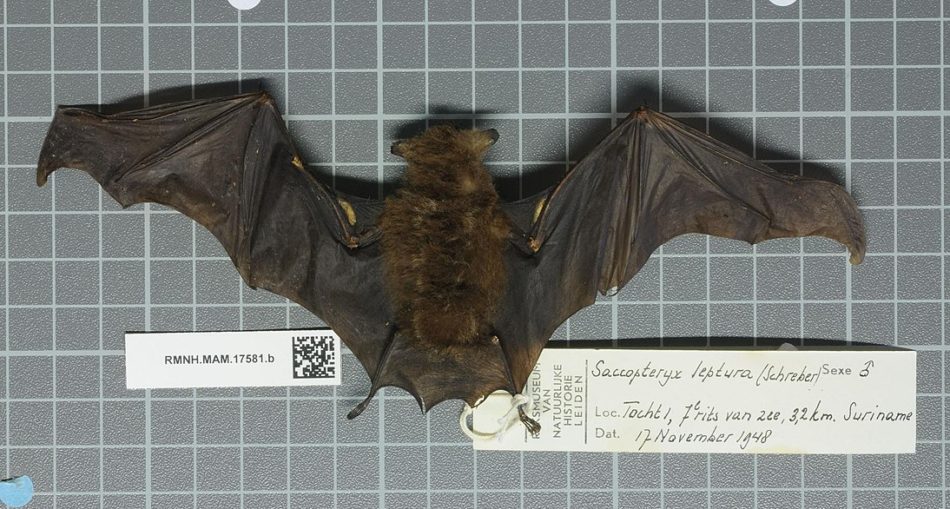You may have heard about blood-sucking Vampire bats, but have you heard about the Sac-Winged Bats? Noted for the odoriferous gland in their wings, this species of bats is native to Central America and South America in countries including Guyana, Brazil and Suriname. They can be recognized by the glands on its wings, used in scent rituals. The bats can be detected by their strange, odiferous smells. This species of bats live in forested areas and eat tons of flying insects. While the scientific name of the Lesser Sac-Winged Bat is Saccopteryx leptura, the mammal is also known as the lesser white-lined bat.
The Lesser Sac-Winged Bat belongs to a genus called Saccopteryx which include other sac-winged bats such as the Antioquian sac-winged bat (Saccopteryx antioquensis), Greater sac-winged bat (Saccopteryx bilineata), Frosted sac-winged bat (Saccopteryx canescens), Amazonian sac-winged bat (Saccopteryx gymnura).

Specimen of The Lesser Sac-Winged Bat on display – Photo By Naturalis Biodiversity Center, CC0, https://commons.wikimedia.org/w/index.php?curid=44510065
Description Of The Lesser Sac-Winged Bat
The Lesser Sac-winged BAt or the Lesser White-Lined Bat was named for the white strips that starts at its shoulders and proceed to run vertically down the rest of its back. The body of this bat is covered in fur which normally brown, with the exception of its dark, leathery wings. The mammal is usually about forty-five (45) mm in length.
The bat is categorized under sac-winged bats because it has an unpleasant smelling gland, on the distal portion of its arm. The dorsal part of its wing has the opening of the gland, which is larger in the males than their female counterparts. Sexual dimorphism is present in the Lesser Sac-Winged Bats species as the females generally larger than the male.
Scientific Information of the Lesser Sac-Winged Bat
- Kingdom: Animalia
- Phylum: Chordata
- Class: Mammalia
- Order: Chiroptera
- Family: Emballonuridae
- Genus: Saccopteryx
- Species: S. leptura
Habitat Of The Lesser Sac-Winged Bat
This mammal tends to inhabit areas that are heavily forested where they would roost in surrounding trees with no noticeable preference of trees. However, the Lesser Sac-Winged will roost higher in the canopy, compared to other species. Lesser Sac-Winged Bats can typically be found in areas of low elevation but can be found in areas up to nine hundred (900) metres high. While the Lesser Sac-Winged Bats seem to prefer open roosting areas, they also roost in the interior of buildings. This particular species of bats avoid places near bodies of water. The species may be found roosting and mingling with other species however they do no share the same foraging areas.
Diet Of The Lesser Sac-Winged Bat
The Lesser Sac-Winged Bat diet strictly comprises of aerial insects like sawflies, wasps, bees, and flying ants and the non-flying. The mammal likes to forage canopies of trees, using echolocation to hunt their prey.
Behaviour Of The Lesser Sac-Winged Bat
During their hunts the Lesser Sac-Winged Bats do not change the size of their mouth when hunting nor do they change their calling frequency. The mammal tends to roost in groups ranging from two to nine (2-9), forming small groups. Their colonies are made up of about fifty (50) bats. The females are protective of their foraging areas and will defend them, unlike their male counterparts. While females may switch harems the males usually remain in their territories. After hunting, the male bats sing for its returning females, indulging in very long, complex songs. During this, they also perfume their females with their unique scent.
Reproduction Of The Lesser Sac-Winged Bat
It is believed that the Lesser Sac-Winged Bat is monogamous which is a rare thing for a mammal. The female will select a male by its scent. The female produces about one or at most two young annually. They give birth in May and in either October or November. The pups cannot fly for the first two weeks following their birth and are taken care of by their mother for up to eighteen (18) months, just short of a year. In order to forage, the female leaves her pup or pups in another roost, a secret place where they can stay safe for the night. In the morning she retrieves them and returns them to their daytime roost.
About The Lesser Sac-Winged Bat
You can smell the Lesser Sac-Winged Bat from a mile away due to its unique and somewhat unpleasant scent. Released from the scent sacs on their wings, the scent is one of the most distinguishing characteristics of the bat. It is very similar to the Greater Sac-Winged Bat and shares many characteristics with species in its genus Saccopteryx.
Article References
- https://en.wikipedia.org/wiki/Lesser_sac-winged_bat
- http://www.wikiwand.com/en/List_of_mammals_of_Guyana
- https://en.wikipedia.org/wiki/Saccopteryx
- http://www.thenighttour.com/alien2/white_lined_bats.htm







